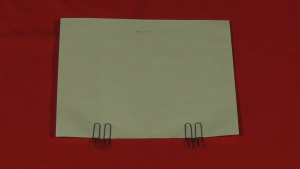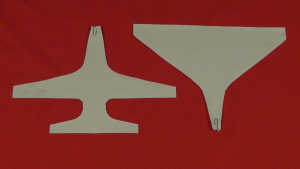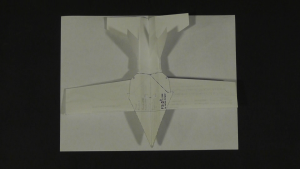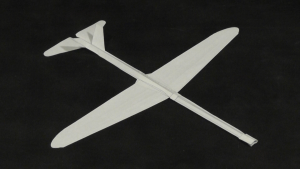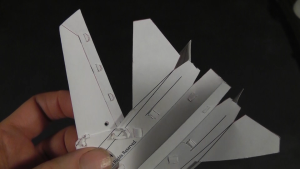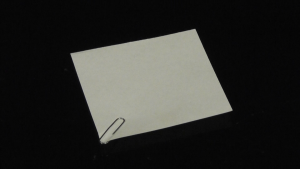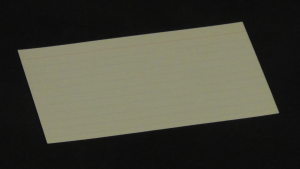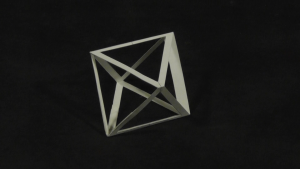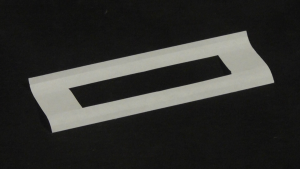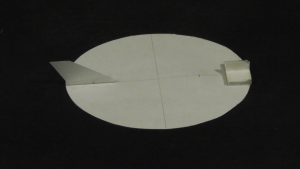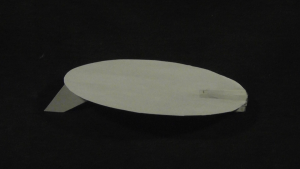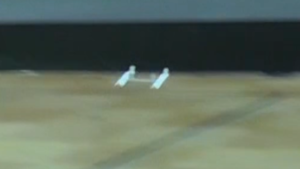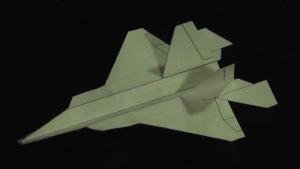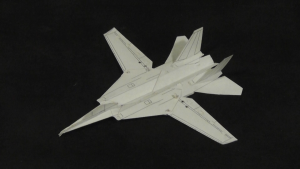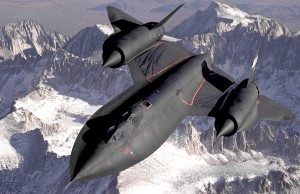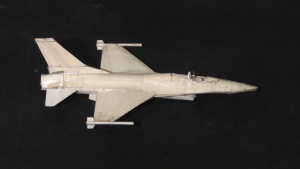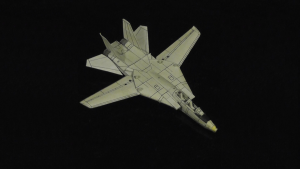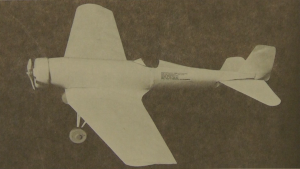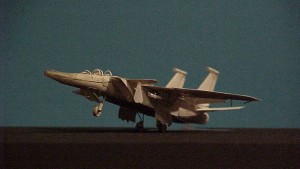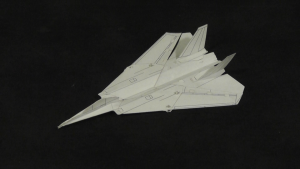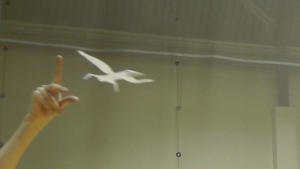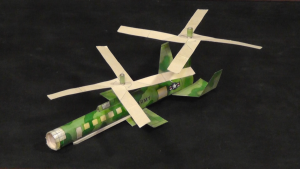Myths & Facts
Rethinking Folded Craft
Myth: Origami is the best way to create a high performance paper aircraft.
Fact: Aircraft can go farther, higher, stay up longer, turn tighter, fly more accurately and survive more crashes using the full range of construction techniques, paper types, tape, glue, staples & paperclips.
Myth: You can’t make a paper airplane without folding.
Fact: With skill, you can fly a sheet of paper with just paper clip ballast and careful shallow bends.
Fact: Easier non-origami planes can be made by both cutting and adding ballast.
Myth: You can’t fold an big airplane that looks like a regular airplane and flies OK without adding or cutting off paper.
Fact: This airplane was folded after cutting that did not detach any paper, and uses nothing else (tape, glue, etc.)
Myth: You can’t make a paper airplane bigger than the sheet it’s made from.
Fact: This cut and folded airplane is bigger than the sheet it came from, is still all one piece, and uses nothing else (tape, glue, etc.)
Fact: Larger one sheet airplanes are possible if cut paper is rejoined with tape and glue.
Myth: If you can’t use tape or glue, you can’t rejoin paper you cut off.
Fact: Paper can be folded back in to stay. Expert cut and fold techniques can hold paper together almost like tape or glue.
Super Easy Designs & Thinking Outside the Box
Myth: The simplest paper airplane is a dart.
Fact: Years ago I devised what may be the World’s Easiest Paper Airplane, made by pinching a paper clip on a flat piece of paper.
Myth: Non-airplane paper aircraft are harder to make than paper airplanes.
Fact: The World’s Easiest Paper Aircraft is an index card. It comes ready to fly! Depending its size, stiffness and flatness, it might fly as a tumbling wing or Frisbee, or both.
Myth: Weird shapes don’t fly.
Fact: If you understand aerodynamics, you can make many things fly, like this octahedron.
How Many Ways Can You Fly?
Myth: Paper airplanes and paper aircraft are the same thing.
Myth: Tumbling wings, Whirlybirds, flying disks and rings are paper airplanes.

Fact: Aircraft are ALL types of “flying” craft, including airplanes.
Fact: Airplanes are the common type of aircraft with fixed wings that do not move (unlike a bird or helicopter) and a nose that tends to point forward and a lifting side that tends to point up or bank and pitch to turn an maneuver.
Myth: Aircraft fly only one way.
Fact: This aircraft glides like an airplane till it stalls, then it goes sideways like a tumbling wing.
Myth: Airplanes fly just one way.
Fact: Many airplanes can fly upside down or right side up (2 airplane flight modes.) Some glide stably either way without retrimming the controls. A few can even stall, flip over and glide the other way.
Myth: Airplanes only fly forward.
Fact: This craft can sustain a speed seeking airplane glide forwards or backwards.
Maximum Performance:
Myth: Planes that turn tightly don’t fly far.
Fact: This F-22 can turn around in a very small space, or fly down a basketball court! (photo and/or link)
Myth: A plane has to go very high to stay up a long time.
Fact: Time aloft depends on time to climb, peak height and descent rate. Slower descents need less height, sometimes less than one’s reach to win a contest.
Myth: The slowest descent possible is about 1 1/2 feet per second, with planes used by Ken Blackburn or Takuo Toda.
Fact: There are bond paper airplanes descending much slower than 1 foot per second. If cutting were allowed at the Red Bull Paper Wings contest, a good cut and folded “paper only” plane (no tape or glue), launched from a high reach could win time aloft some years.
Myth: Spear darts go farther than flying airplanes.
Fact: I've been able to fly farther than I can throw a dart most of my life, even at the same weight. The 2012 distance record thrown by Joe Ayoob and designed by John Collins actually flew. This is hard to do under PAA rules.
Construction Methods:
Myth: There are only a few ways to make paper aircraft, like origami, profile (flat fuselage) cardstock and 3D scale models.
Fact: There are MANY ways! I've devised methods like non-origami (no folds allowed), and folded kirigami that somewhat replaces tape and glue. The more ways you learn, the better you get at each one.
Myth: Scale models don’t maneuver well, win records or withstand hard landings.
Fact: In 1982, Eugene Sykes set a Guinness World Distance Record with a scale model SR-71, flown low. My F-14, F-15 and F-16 have over 1,000 flights each, including aerobatics!
Moving Parts & Technological Supercraft:
Myth: You can't make a good paper landing gear.
Fact: Rob and Don Burnham entered a scale Boeing monomail with a spinning propeller that landed on laminated heavy paper tires on a paper axle in the 2nd Great International Contest in 1985. (Used with permission.)
Fact: My 1982 X-28mk-3 lands on retractable rolling landing gear, made with posterboard tires mounted on staples.
Myth: Moving flying surfaces and swing wings aren’t practical on paper airplanes.
Fact: I've made wings that swing, have extendable edges, variable geometry canards and strakes and hinged surfaces since the 1970s. Expertly done, they can sometimes add more performance than the extra weight costs. However, if they are too heavy or complex, they are mostly for show.
Myth: You can’t make a good flying swing-wing F-14 by only cutting and folding paper that is still all one piece.
Fact: My "Folded Kirigami" F-14 (photo) is probably the world’s first good flying monolithic (single piece) cut & fold swing wing paper airplane. Parts are connected by paper strings, and held together with cut and folded paper locks. The pivots and locks are Paper pins serve as pivots and locks. It is very lightweight, and aerobatic. It requires great skill, but gets easier with tape and staples.
Myth: Flapping paper birds can't have a long beak and tail.
Fact: Mine does!
Myth: You can't make a paper forward gliding helicopter.
Fact: I won honorable mention in the 2nd Great international Contest with a forward gliding autogyro (engineless helicopter) with blades spinning above the fuselage on rolled paper axles.

